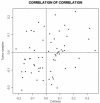Inflammation and breast cancer. Inflammatory component of mammary carcinogenesis in ErbB2 transgenic mice
- PMID: 17705881
- PMCID: PMC2206718
- DOI: 10.1186/bcr1745
Inflammation and breast cancer. Inflammatory component of mammary carcinogenesis in ErbB2 transgenic mice
Abstract
This review addresses genes differentially expressed in the mammary gland transcriptome during the progression of mammary carcinogenesis in BALB/c mice that are transgenic for the rat neu (ERBB2, or HER-2/neu) oncogene (BALB-neuT664V-E mice). The Ingenuity knowledge database was used to characterize four functional association networks whose hub genes are directly linked to inflammation (specifically, the genes encoding IL-1beta, tumour necrosis factor, interferon-gamma, and monocyte chemoattractant protein-1/CC chemokine ligand-2) and are increasingly expressed during such progression. In silico meta-analysis in a human breast cancer dataset suggests that proinflammatory activation in the mammary glands of these mice reflects a general pattern of human breast cancer.
Figures








Similar articles
-
Immunobiology of her-2/neu transgenic mice.Breast Dis. 2004;20:33-42. doi: 10.3233/bd-2004-20105. Breast Dis. 2004. PMID: 15687705 Review.
-
Inhibition of mammary carcinoma development in HER-2/neu transgenic mice through induction of autoimmunity by xenogeneic DNA vaccination.Cancer Res. 2005 Feb 1;65(3):1071-8. Cancer Res. 2005. PMID: 15705909
-
Gene expression profiling of cancer progression reveals intrinsic regulation of transforming growth factor-beta signaling in ErbB2/Neu-induced tumors from transgenic mice.Oncogene. 2005 Aug 4;24(33):5173-90. doi: 10.1038/sj.onc.1208712. Oncogene. 2005. PMID: 15897883 Free PMC article.
-
Functional interaction between mouse erbB3 and wild-type rat c-neu in transgenic mouse mammary tumor cells.Breast Cancer Res. 2005;7(5):R708-18. doi: 10.1186/bcr1281. Epub 2005 Jul 6. Breast Cancer Res. 2005. PMID: 16168116 Free PMC article.
-
Co-opted integrin signaling in ErbB2-induced mammary tumor progression.Cancer Cell. 2006 Aug;10(2):93-5. doi: 10.1016/j.ccr.2006.07.015. Cancer Cell. 2006. PMID: 16904607 Review.
Cited by
-
A comparative phosphoproteomic analysis of a human tumor metastasis model using a label-free quantitative approach.Electrophoresis. 2010 Jun;31(11):1842-52. doi: 10.1002/elps.200900752. Electrophoresis. 2010. PMID: 20446291 Free PMC article.
-
Comparative study and meta-analysis of meta-analysis studies for the correlation of genomic markers with early cancer detection.Hum Genomics. 2013 Jun 5;7(1):14. doi: 10.1186/1479-7364-7-14. Hum Genomics. 2013. PMID: 23738773 Free PMC article.
-
Inflammation-Related Carcinogenesis: Lessons from Animal Models to Clinical Aspects.Cancers (Basel). 2021 Feb 22;13(4):921. doi: 10.3390/cancers13040921. Cancers (Basel). 2021. PMID: 33671768 Free PMC article. Review.
-
Microenvironment, oncoantigens, and antitumor vaccination: lessons learned from BALB-neuT mice.Biomed Res Int. 2014;2014:534969. doi: 10.1155/2014/534969. Epub 2014 Jun 3. Biomed Res Int. 2014. PMID: 25136593 Free PMC article. Review.
-
Comparison of immunity in mice cured of primary/metastatic growth of EMT6 or 4THM breast cancer by chemotherapy or immunotherapy.PLoS One. 2014 Nov 19;9(11):e113597. doi: 10.1371/journal.pone.0113597. eCollection 2014. PLoS One. 2014. PMID: 25409195 Free PMC article.
References
Publication types
MeSH terms
LinkOut - more resources
Full Text Sources
Molecular Biology Databases
Research Materials
Miscellaneous

